Knibb Conquers Dubai Heat to Claim Historic T100 World Title
In brutal heat, Taylor Knibb held off a fierce challenge from Ashleigh Gentle to win both the Dubai T100 and the inaugural World Championship title.

In brutal heat, Taylor Knibb held off a fierce challenge from Ashleigh Gentle to win both the Dubai T100 and the inaugural World Championship title.

Let me tell you about Dubai. Picture this: it's so hot as hell and the air feels like it's trying to cook you alive - we're talking 45°C, the kind of heat that makes you question why anyone would race in it. And there's Taylor Knibb, standing on that start line, probably wondering the same thing.
This was the first-ever T100 World Championship and everyone knew it was going to be special. Knibb might've been the favourite but you should've seen the look in Ashleigh Gentle's eyes at the start. The Aussie had that quiet confidence about her, the kind that makes you think twice about betting against her. Then there was Julie Derron, fresh off her Olympic silver, looking like someone who hadn't come all this way to finish second.
The water was ridiculous - 31 degrees. Think about that for a second. These athletes were about to race in what basically felt like a warm bath. And that was just the start. They had a technical bike course waiting for them that would make Formula 1 drivers nervous, and a run that... well, let's just say running a 10K in Dubai's afternoon heat isn't exactly anyone's idea of fun.
You know those races where you can feel something special is about to happen? This was one of them. Nobody knew who'd handle the heat, who'd crack under the pressure or who'd write their name into the history books as the first T100 World Champion. Not even Knibb, with all her dominance this season, looked entirely sure of what was about to unfold.
Sure, they'd all raced in tough conditions before. But Dubai? Dubai doesn't care about your resume. It doesn't care about your perfect season or your Olympic medals. It just sits there, in all its scorching glory, waiting to see who's got what it takes.
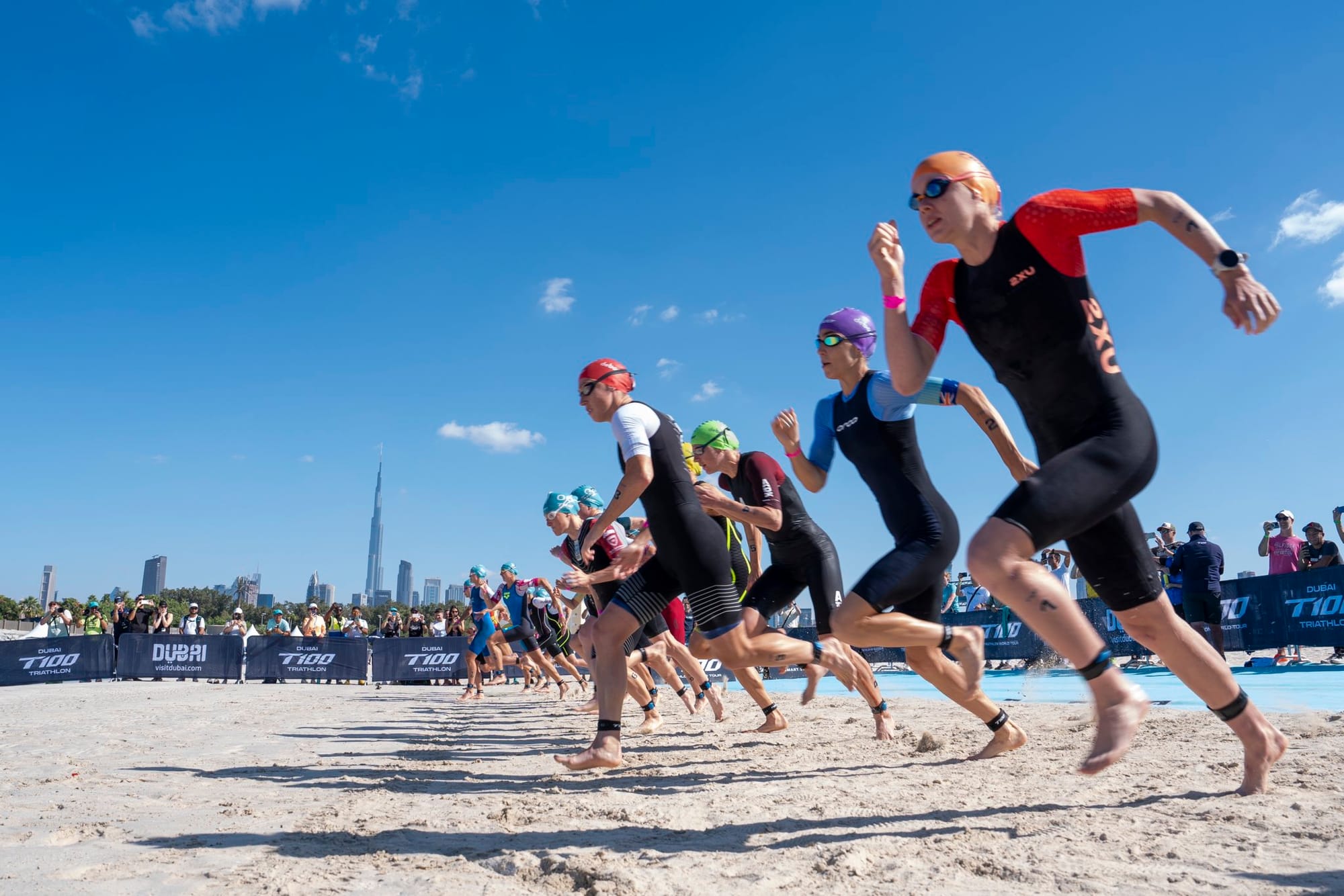
The swim set the stage for what would become an extraordinary race. The course, a two-lap Aussie exit format, was deceptively simple on paper but complicated by extreme conditions. The water temperature hovered at a staggering 31°C, a heat that felt more like a warm bath – no one wants to swim in that – than an open-water swim. The 31°C water elevated core body temperatures quickly, forcing athletes to carefully balance pace and endurance.
From the gun, it was clear this would not be a typical swim. The athletes, aware of the heat's impact, adjusted their strategies. The pace was notably moderated compared to cooler races earlier in the season, allowing a larger lead group to form. Taylor Knibb, known for her powerhouse swims, was uncharacteristically cautious but still managed to establish an early presence at the front. Her orange cap was a beacon of control amidst the churn.
On her feet, Ashley Gentle was delivering a standout performance. Historically, Gentle’s weaker swimming had often left her trailing the leaders. But today, she was determined not to let that narrative define her. Staying tucked behind Imogen Simmons and India Lee, she demonstrated newfound resilience and efficiency, conserving energy while ensuring she remained in contention. I will say, and yes being a little Aussie biased that I can be, I was worried that she might drop off the back and be in no-mans land and waiting for the second bunch to catch up – clearly not ideal.
Not all competitors fared equally in the water. Sarah Perez Sala, the early leader, made the bold choice to forego a swim skin, prioritising heat regulation over buoyancy. The strategy paid dividends as she set the pace, stringing out the field. Others, like Flora Duffy and Taylor Spivey, opted for swim skins but struggled to find the same rhythm.
Gentle’s position near the back of the lead pack drew attention. Her high stroke rate, though demanding, was a calculated effort to stay within reach. Unlike previous races, where she might have faltered under such intensity, Gentle’s form remained composed, a testament to her preparation and determination.
The Aussie exit highlighted a surprising dynamic—Taylor Knibb couldn’t splinter the field as usual, leaving seven athletes, including Gentle and Derron, in the hunt.
Ashley Gentle’s confidence surged as she overtook a couple of competitors while re-entering the water. The momentum of her swim built steadily—a psychological boost that would carry her through the transitions and onto the bike. Meanwhile, Knibb appeared aware of the unusual dynamics. Glancing back, she registered the size and quality of the group. This wasn’t a swim where she could count on a solo break; she’d need to battle through the pack.
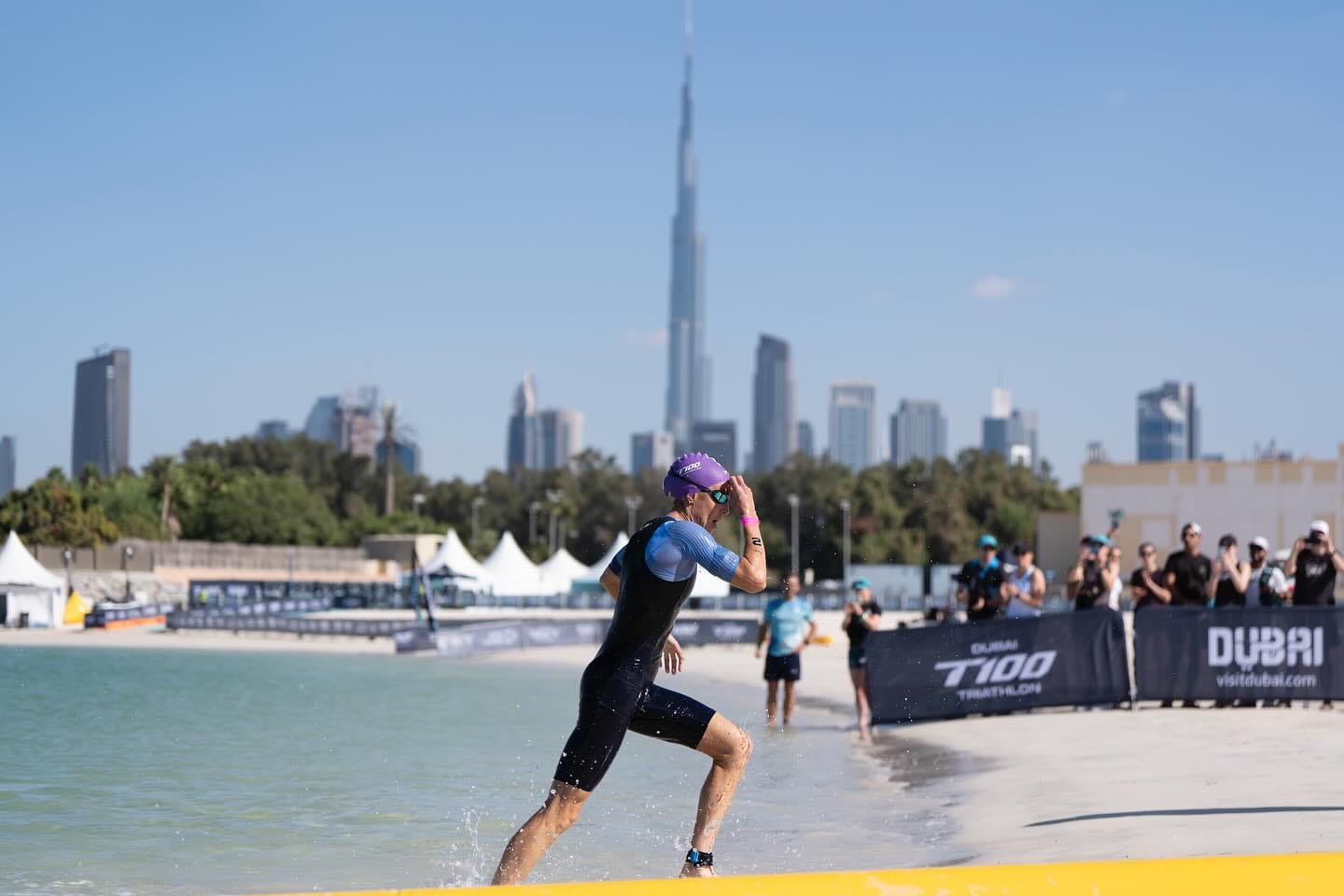
As the race transitioned into the second lap, the pace quickened. Sarah Perez Sala continued to lead – her stroke long and powerful. Behind her, Taylor Knibb began to assert herself, edging closer to the front. The group stretched, but Ashley Gentle, now fully committed, refused to let the elastic snap. Each stroke from Gentle seemed to declare her intent: today would not be a race of missed opportunities.
By the end of the swim, the lead pack had thinned slightly but remained larger than expected. Taylor Knibb exited the water with Ashley Gentle and Julie Derron close behind, a rarity in this season's races.
The oppressive heat forced athletes to adapt their effort levels, leading to a more compact and unpredictable field. Post-race interviews revealed just how draining the swim had been. Competitors described it as swimming through “treacle,” with every stroke feeling heavier than the last.
For Ashley Gentle, the swim was a critical victory in itself. Not only had she emerged unscathed, but she had also set the tone for a day of defying expectations. Taylor Knibb, for her part, showed poise under pressure, exiting the water ahead but far from alone—a sign of the battles that lay ahead.
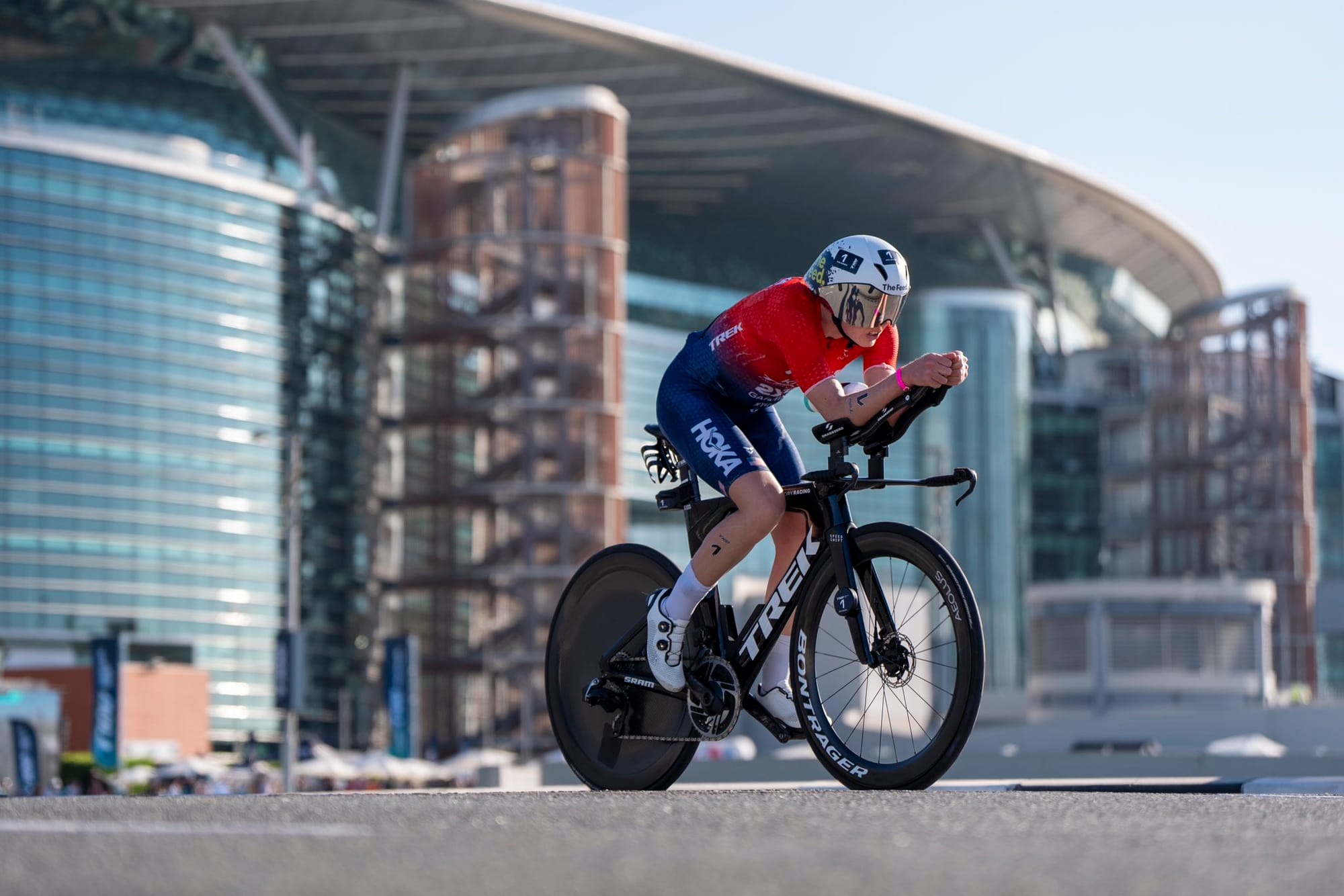
If the swim in Dubai’s scorching waters was a test of endurance, the bike leg was a crucible for strategy and skill. Spanning seven loops of a technical course, the 70km ride demanded not only raw power but precision and adaptability and sprinkling of nerves of steel. It was here that the dynamics of the race began to take shape, as the women battled the punishing heat, sharp turns and the relentless pace set by the leaders.
Unlike typical courses favouring straight-line speed, Dubai’s technical layout challenged even the most experienced. The numerous corners and short inclines placed a premium on bike-handling skills, rewarding those who could maintain momentum through tight turns and penalising those who faltered. Taylor Knibb, known for her dominance on flat, power-based courses, found herself facing a different kind of challenge.
Imo Simmonds with a nutritional nightmare as she drops a bottle whilst riding!
— T100 Triathlon World Tour (@t100triathlon) November 16, 2024
She will have to serve a 30s penalty for littering to add insult to injury 😩
📺 WATCH DUBAI T100 LIVE: https://t.co/5TiASDaWI9 pic.twitter.com/IVHxMZ8OrX
Early in the bike leg, Sarah Perez Sala continued her strong showing from the swim, leading the field onto the flat opening section. Taylor Knibb, however, was quick to move up, aware that she needed to establish control early. But it wasn’t business as usual for the American powerhouse. Julie Derron, fuelled by her silver-medal ambitions, attacked aggressively, forcing Knibb into an uncharacteristic game of catch-up.
For Gentle, the bike was an opportunity to showcase her offseason improvements. Historically, Gentle had struggled to stay with the lead pack on the bike, often losing valuable time to the likes of Knibb and Derron. But in Dubai, she displayed a newfound tenacity. Attacking on technical sections, Gentle stayed glued to the leaders, refusing to let the race slip away.
Her high cadence, honed during months of targeted training at home in hot conditions, proved invaluable. While others faltered under the combined weight of the heat and technical demands, Gentle maintained her rhythm. Each corner was taken with precision, each climb approached with intent—a stark contrast to her struggles earlier in the season.
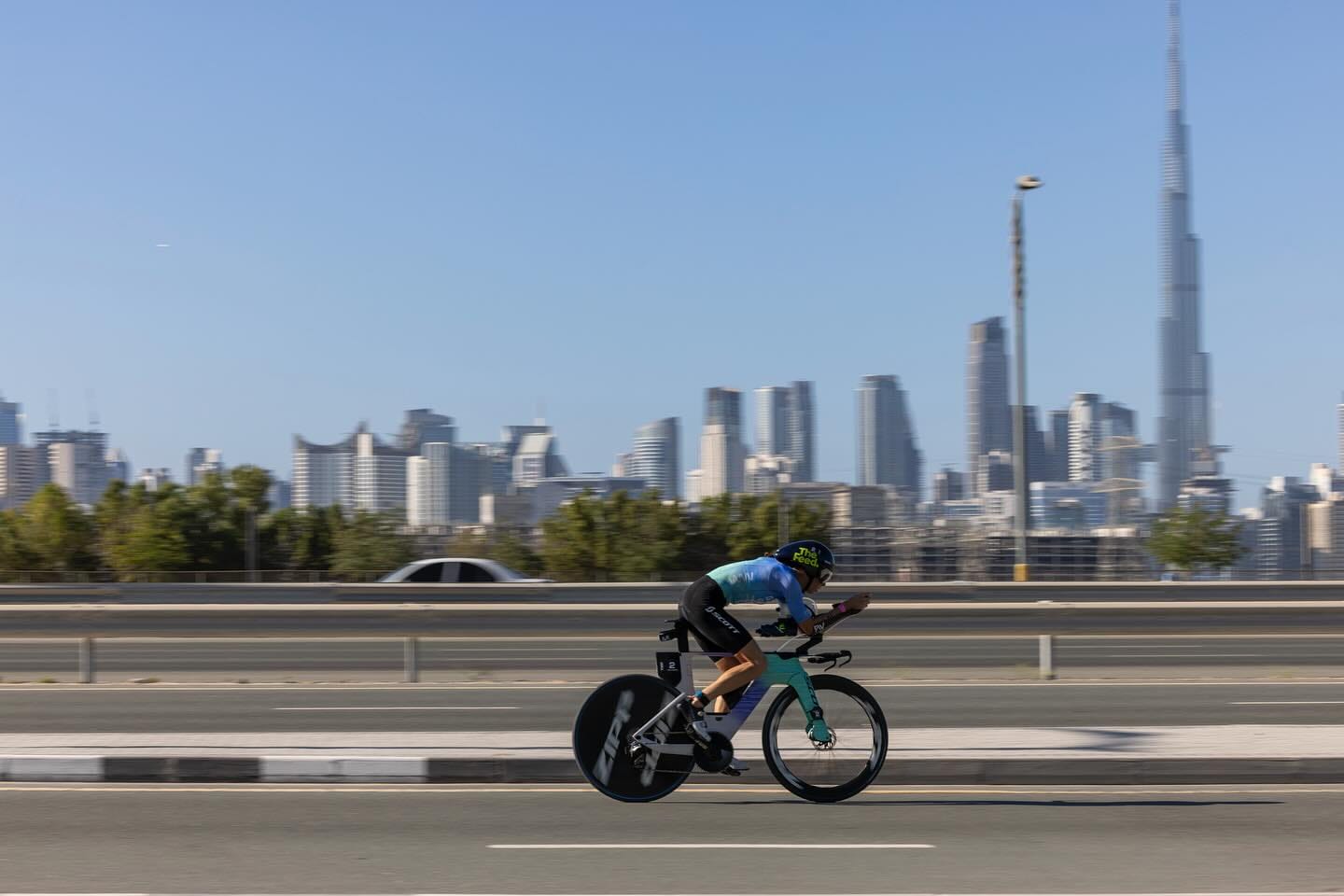
Julie Derron emerged as the surprise protagonist of the bike leg. Displaying the form and confidence that had earned her an Olympic silver medal, she attacked from the outset, taking the lead and refusing to let go. Derron’s fluidity through corners and her ability to accelerate out of technical sections kept the pressure on Knibb and the chasing pack.
Her boldness rattled the field, especially Knibb, who was unaccustomed to chasing. Derron’s aggressive approach wasn’t just about gaining time; it was about sending a message. For the first time this season, Knibb was forced to react rather than dictate.
Taylor Knibb’s raw power has often been her trump card, allowing her to dominate bike legs with brute force. However, Dubai’s technical course exposed a vulnerability. Knibb’s cornering, while improved under the guidance of a technical coach, lacked the fluidity of Derron or the precision of Gentle. Every tight turn seemed to cost her precious seconds, forcing her to expend more energy to stay in contention.
On the longer straight sections, Knibb worked to close gaps, but her body language betrayed an athlete under pressure. Glances over her shoulder—a rare sight for the typically composed competitor—suggested a growing awareness that this race was far from decided.
Dubai’s searing afternoon heat was an ever-present factor. Athletes took extraordinary measures to stay cool, with some placing ice down their suits during transitions. Despite these efforts, the heat sapped energy, turning the bike leg into a war of attrition. Heart rates soared, with many athletes riding near their maximum just to stay in contention.
As the kilometers ticked by, the race began to take on a familiar yet thrilling shape. By the midway point, the “Big Three” of Taylor Knibb, Julie Derron and Ashley Gentle had established themselves at the front. While Knibb managed to reel in Derron and regain the lead, the effort it took was evident. Derron, ever tenacious, stayed close, while Gentle continued to ride the race of her life, never letting the leaders out of her sight.
The final laps of the bike leg brought the athletes to the most technical part of the course, a series of sharp corners and elevation changes around the Maiden Center. Here, Derron and Gentle demonstrated their superior handling skills, gaining back precious seconds on Knibb. For Gentle, this was a turning point; her ability to keep pace on a section that traditionally favoured more technical riders.
The bike finished with all three women entering T2 within striking distance of one another—a scenario almost unthinkable at the season’s start. Taylor Knibb led into T2, but her usual dominance was absent. Derron’s aggression and Gentle’s persistence had turned the race into an open contest, with the run set to decide the first-ever T100 World Champion.
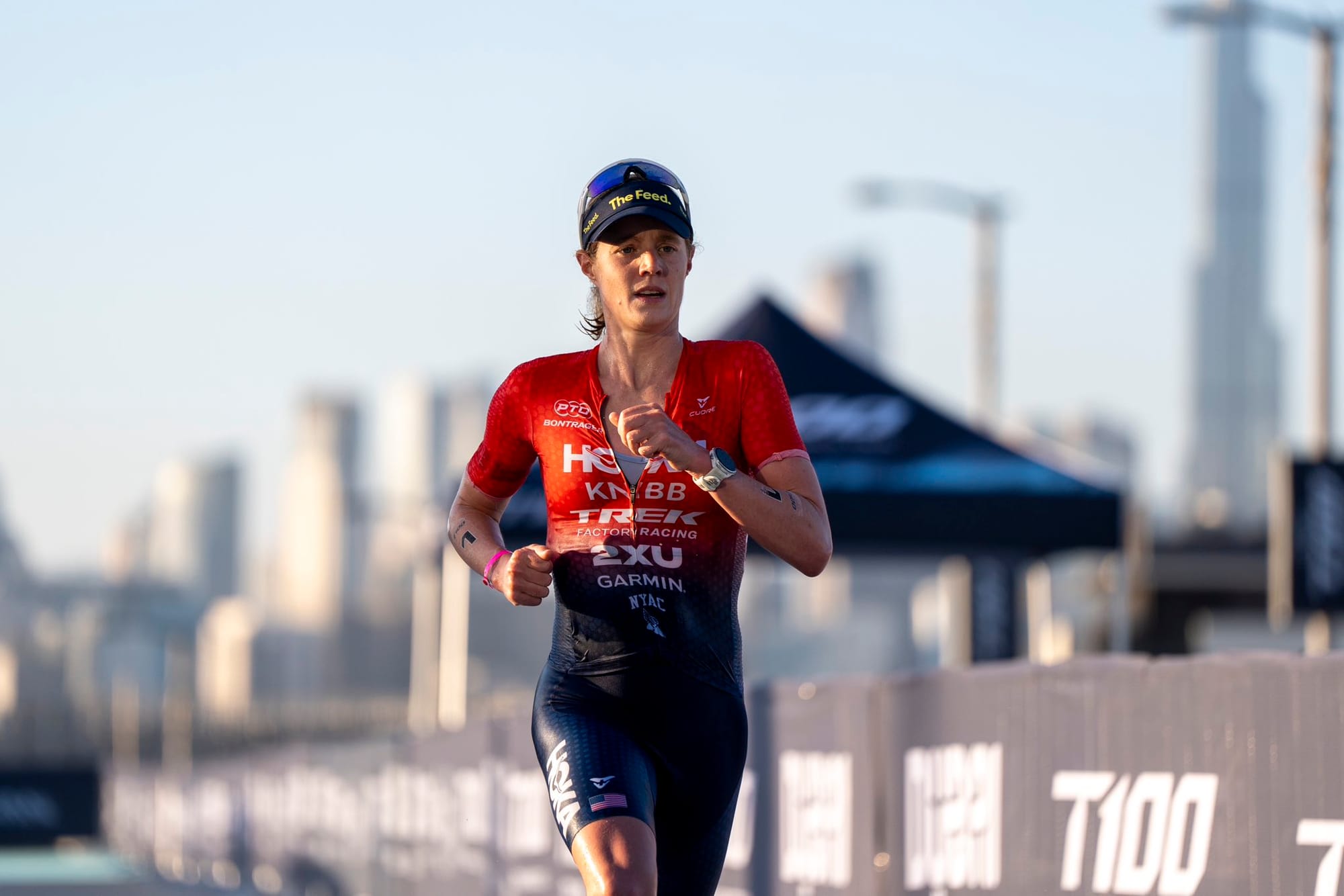
The final leg of the race unfolded as a true spectacle of endurance and determination. With the sweltering desert heat intensifying, the run demanded not just physical resilience but also precise pacing and tactical execution. It was here, over seven laps of a flat yet punishing course, that the battle for the title reached its dramatic conclusion.
As they transitioned into the 10km run, Taylor Knibb held a narrow lead. Her performance on the technical bike course, though not flawless, had been enough to put her in front of her rivals, Ashley Gentle and Julie Derron. The gaps were tight—Gentle was just 20 seconds behind, with Derron another 10 seconds back.

The conditions, with the temperature nearing 45°C in the open air, added another layer of challenge. Heart rates soared as athletes battled dehydration, muscle fatigue and the mental toll of the race.
Knibb’s approach on the run was clear: maintain a steady pace to protect her lead. Known for her ability to hold a high tempo over longer distances, Knibb clocked her first km at 3:45, a pace designed to discourage attacks while conserving energy. However, the heat and the relentless pace began to show. Her posture, typically upright and efficient, began to falter slightly by the halfway mark.
Despite her strengths, Knibb was keenly aware of her rivals. Gentle’s reputation as one of the strongest runners in the field, particularly in hot conditions, loomed large. To win, Knibb needed to prevent Gentle from closing the gap.
Ash approached the run with her trademark tactical acumen. Starting slightly slower than Knibb, Gentle gradually increased her pace, reducing the gap with each passing kilometre. Her steady cadence and controlled breathing were signs of an athlete who had prepared meticulously for this moment.
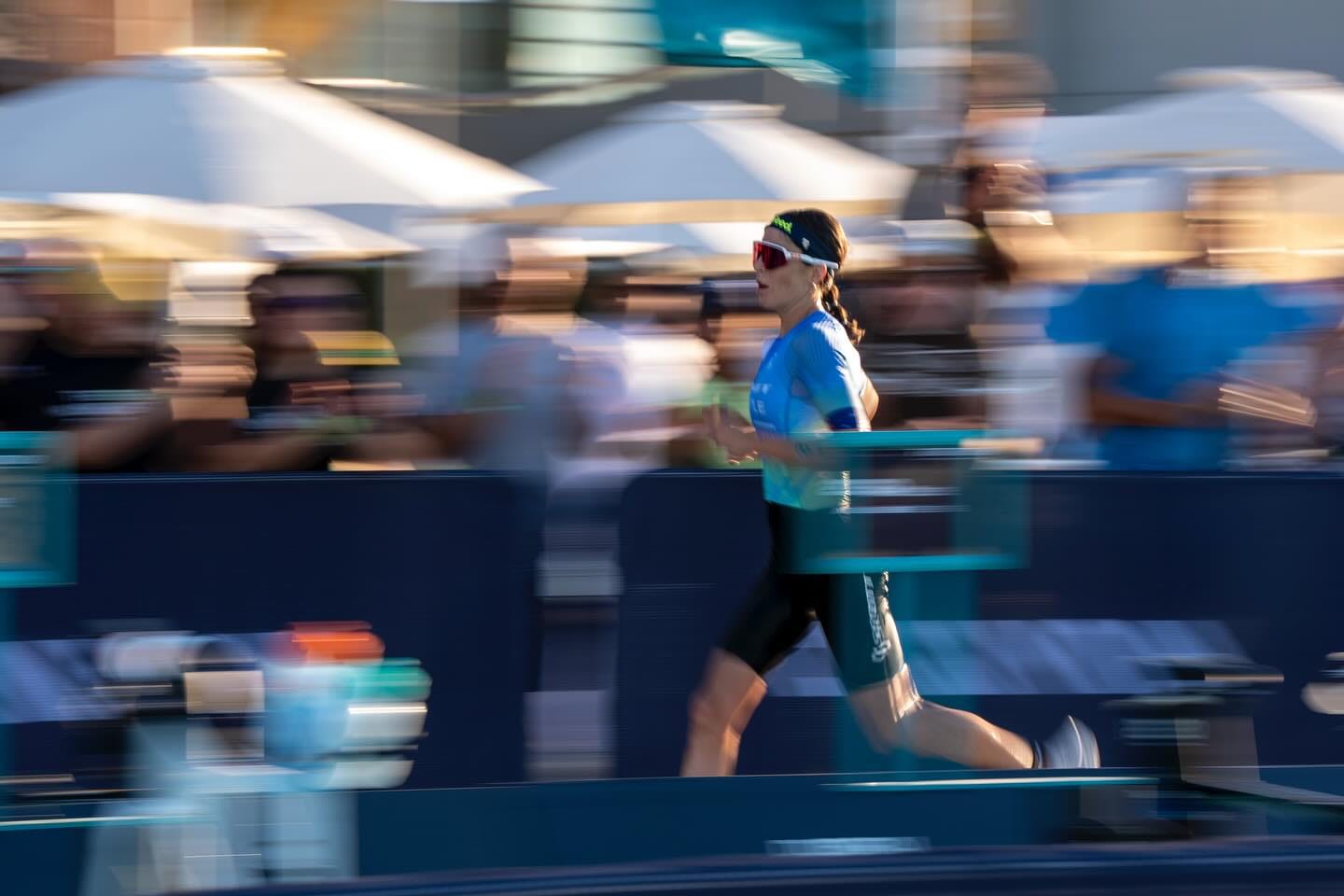
By the 5km mark, Gentle had halved Knibb’s lead. Her split time of 18:45 for the first half of the run highlighted her controlled aggression. The mental game was as important as the physical and Gentle’s focus never wavered. Each step brought her closer to rewriting the narrative of her season.
The 2020 Olympic champ is running FAST! 🔥
— T100 Triathlon World Tour (@t100triathlon) November 16, 2024
Flora Duffy moves into fourth, passing Imogen Simmonds with ease in Dubai.
📺 WATCH DUBAI T100 LIVE: https://t.co/5TiASDaWI9 pic.twitter.com/QheYjqWGt8
While Gentle and Knibb commanded attention, Julie Derron quietly executed a run that kept her in contention. Known for her finishing strength, Derron stayed within striking distance, biding her time. Her even pacing and efficient form suggested she was conserving energy for a late surge.
The heat, however, proved challenging even for the resilient Derron. By the sixth lap, the gap to Gentle and Knibb had widened slightly, but she remained committed, knowing the unpredictable nature of triathlon could still play in her favour.
As the athletes entered the final two kilometers, the gap between Knibb and Gentle had narrowed to just 10 seconds. Spectators along the course sensed a potential upset. Gentle, fueled by the cheers and the belief that the race was still hers to win, increased her pace to under 3:40 per kilometer.
ASHLEIGH GENTLE STOPS! 😱
— T100 Triathlon World Tour (@t100triathlon) November 16, 2024
The T100 world title and the Dubai T100 win slips away from the Australian as she comes to a halt in the final few kms of the run. pic.twitter.com/DCINxH0nRt
Knibb, now visibly fatigued, glanced over her shoulder—a rare sign of concern from the usually composed athlete. The psychological pressure was immense. She dug deep, using every ounce of energy to maintain her lead.
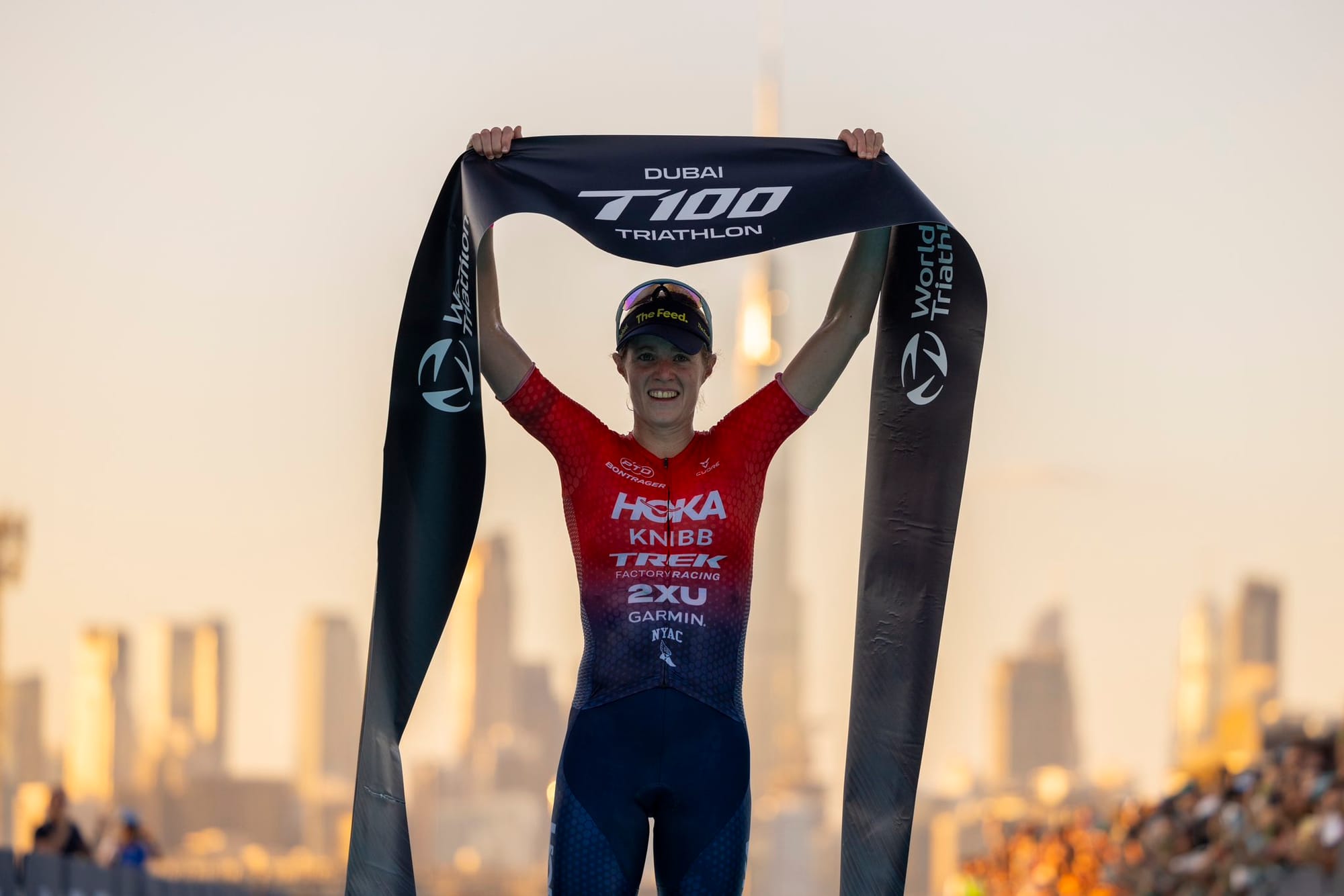
Taylor Nib maintained her lead despite the sweltering heat and pressure from her rivals. Crossing the line in 3:29:17, Nib secured the victory and claimed the first-ever T100 Triathlon World Championship title.
Julie Derron’s consistent performance earned her second place with a time of 3:31:08, while Ashley Gentle, finishing in 3:31:42, rounded out the podium.

| Position | Athlete | Swim time | Bike time | Run time | Overall time |
| 1 | Taylor Knibb (USA) | 26:36 | 01:54:18 | 01:06:26 | 03:29:17 |
| 2 | Julie Derron (SUI) | 26:37 | 01:57:29 | 01:05:35 | 03:31:08 |
| 3 | Ashleigh Gentle (AUS) | 26:43 | 01:57:15 | 01:06:00 | 03:31:42 |
| 4 | Flora Duffy (BER) | 26:39 | 02:01:03 | 01:03:32 | 03:33:05 |
| 5 | Kat Matthews (GBR) | 29:18 | 01:57:23 | 01:05:28 | 03:34:18 |
| 6 | Lucy Byram (GBR) | 29:12 | 01:56:14 | 01:07:47 | 03:34:56 |
| 7 | Laura Philipp (GER) | 29:43 | 01:57:04 | 01:07:17 | 03:36:01 |
| 8 | Taylor Spivey (USA) | 26:34 | 02:03:15 | 01:04:56 | 03:36:23 |
| 9 | Imogen Simmonds (SUI) | 26:42 | 01:57:13 | 01:10:55 | 03:36:41 |
| 10 | Anne Haug (GER) | 29:16 | 02:00:27 | 01:05:36 | 03:37:29 |
| 11 | Paula Findlay (CAN) | 28:13 | 01:57:55 | 01:10:36 | 03:38:42 |
| 12 | India Lee (GBR) | 26:50 | 01:58:21 | 01:13:22 | 03:40:34 |
| 13 | Kaidi Kivioja (EST) | 29:16 | 01:59:12 | 01:11:33 | 03:41:55 |
| 14 | Laura Madsen (DEN) | 29:17 | 02:00:47 | 01:10:10 | 03:42:05 |
| 15 | Marlene De Boer (NED) | 29:40 | 02:02:39 | 01:08:57 | 03:43:33 |
| 16 | Sara Perez Sala (ESP) | 26:31 | 02:02:35 | 01:12:46 | 03:43:53 |
| 17 | Kate Curran (GBR) | 28:11 | 02:07:08 | 01:08:38 | 03:46:11 |
| 18 | Marjolaine Pierré (FRA) | 28:14 | 02:03:28 | 01:15:25 | 03:49:11 |
| 19 | Diede Diederiks (NED) | 33:34 | 2:03:23 | 1:13:33 | 3:52:25 |